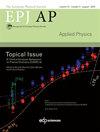Mean multiplication gain and excess noise factor of GaN and Al0.45Ga0.55N avalanche photodiodes
IF 0.9
4区 物理与天体物理
Q4 PHYSICS, APPLIED
引用次数: 3
Abstract
In this work, Monte Carlo model is developed to investigate the avalanche characteristics of GaN and Al0.45 Ga0.55 N avalanche photodiodes (APDs) using random ionization path lengths incorporating dead space effect. The simulation includes the impact ionization coefficients, multiplication gain and excess noise factor for electron- and hole-initiated multiplication with a range of thin multiplication widths. The impact ionization coefficient for GaN is higher than that of Al0.45 Ga0.55 N. For GaN, electron dominates the impact ionization at high electric field while hole dominate at low electric field whereas Al0.45 Ga0.55 N has hole dominate the impact ionization at higher field while electron dominate the lower field. In GaN APDs, electron-initiated multiplication is leading the multiplication gain at thinner multiplication widths while hole-initiated multiplication leads for longer widths. However for Al0.45 Ga0.55 N APDs, hole-initiated multiplication leads the multiplication gain for all multiplication widths simulated. The excess noise of electron-initiated multiplication in GaN APDs increases as multiplication widths increases while the excess noise decreases as the multiplication widths increases for hole-initiated multiplication. As for Al0.45 Ga0.55 N APDs, the excess noise for hole-initiated multiplication increases when multiplication width increases while the electron-initiated multiplication increases with the same gradient at all multiplication widths.GaN和Al0.45Ga0.55N雪崩光电二极管的平均倍增增益和多余噪声系数
在这项工作中,建立了蒙特卡罗模型来研究GaN和Al0.45 Ga0.55 N雪崩光电二极管(apd)的雪崩特性,采用随机电离路径长度结合死空间效应。仿真包括了在一定宽度范围内电子和空穴激发倍增的冲击电离系数、倍增增益和多余噪声因子。GaN的冲击电离系数高于Al0.45 Ga0.55 N, GaN在高电场下以电子为主,在低电场下以空穴为主,而Al0.45 Ga0.55 N在高电场下以空穴为主,在低电场下以电子为主。在GaN apd中,电子引发的倍增在更薄的倍增宽度处领先倍增增益,而空穴引发的倍增在更长的倍增宽度处领先倍增增益。然而,对于Al0.45 Ga0.55 N apd,在模拟的所有倍增宽度下,孔洞引发的倍增增益都领先于倍增增益。GaN apd中电子引发倍增的过量噪声随着倍增宽度的增大而增大,而空穴引发倍增的过量噪声随着倍增宽度的增大而减小。对于Al0.45 Ga0.55 N apd,空穴引发的倍增噪声随倍增宽度的增加而增加,而电子引发的倍增噪声在所有倍增宽度下都以相同的梯度增加。
本文章由计算机程序翻译,如有差异,请以英文原文为准。
求助全文
约1分钟内获得全文
求助全文
来源期刊
CiteScore
1.90
自引率
10.00%
发文量
84
审稿时长
1.9 months
期刊介绍:
EPJ AP an international journal devoted to the promotion of the recent progresses in all fields of applied physics.
The articles published in EPJ AP span the whole spectrum of applied physics research.

 求助内容:
求助内容: 应助结果提醒方式:
应助结果提醒方式:


